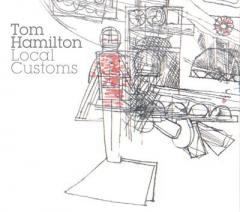TOM HAMILTON / Local Customs
Jacqueline Martelle (flute); Richard Cohen (clarinets); James Martin (trombone); Terry Kippenberger (contrabass); Rich O¹Donnell (percussion); Tom Hamilton (electronic harmony generator)
Tom Hamilton is unquestionably among the most inquisitive minds around. Local Customs explores some obscure notions about music theory and performance practice, leading to sound combinations that are at once unsettling and yet somehow familiar. One discovers that there is very little in Local Customs that follows from conventionally intentional music writing. It is perhaps better to regard it as a group of artifacts of little-known origins, modified through new transformations into something further unexplained.
The foundation for the piece is an "electronic harmony generator" that plays an endless sequence of chords exhibiting curious relationships with no purposeful direction. The musical lines for the ensemble consisting of flute, clarinets, trombone, contrabass, percussion, and electronic harmony - accumulated from coding and decoding various readings, investigations, and experiences during a summer residency in Italy.
TRACK LIST
Corral (11:47)
BRQ Ten (5:01)
Counterpoint Four (11:40)
What Fell Through (8:11)
All The Mapping Shifted (9:00)
REVIEWS
Dan Warburton, Paris Transatlantic
Local Customs, whose five movements follow each other without a break, uses an "electronic harmony generator" developed by the composer during a residency in Italy in the summer of 2005, to, as the press release puts it, explore "some obscure notions about music theory and performance practice, leading to sound combinations that are at once unsettling and yet somehow familiar." Scored for an ensemble consisting of Hamilton's keyboards, along with flute, clarinet, trombone, bass and percussion, the result manages to be curiously arresting and forgettable, restful and restless, satisfying and frustrating, all at the same time. The ear constantly wants things to resolve a certain way – they never do – and each time it gives up trying it's called upon to make another attempt. Cage's reworked Satie (Cheap Imitation) and partially-erased William Billings (Hymns and Variations) come to mind, but even there you can guess (just about) where the music's going, or should be going, or what's missing. In Local Customs a tonal centre is often hinted at – long stretches of "Counterpoint Four" feel like they're in C# minor, thanks to the frozen pitches and predominance of the C#-E minor third, but of course they're not really in any key at all. Diatonic intervals abound, but we're a long way from the "non-tonal diatonic music" of late Ligeti, too. Rich O' Donnell's spare percussion work often recalls Cesar Burago's inspired playing with Sei Miguel, but Hamilton's music doesn't swing in anything like the same way. In fact it doesn't swing at all. Rhythmically, it's quite regular, slightly stilted at times ("BRQ Ten"), and even when it appears to loosen up ("All The Mapping Shifted") it's clear it's still being held in place by a severe compositional logic somehow beyond our comprehension. Or is it?
Ed Pinsent, The Sound Projector
Noted American minimalist Tom Hamilton takes a somewhat different approach on Local Customs (MUTABLE MUSIC MUTABLE 17533-2), where he works his electronic harmony generator alongside a chamber ensemble of players equipped with flute, clarinet, trombone, contrabass and percussion. Much more conspicuously composed than the Australian record above, Local Customs achieves its affects through careful alignment of long dissonant passages that don’t quite appear to relate to each other, yet neither do they draw attention to the mismatching processes that are taking place. The results keep the listener in a state of perpetual expectation, as potentially familiar sounding-instruments begin to lose their identity through swimming in fields of alienating currents. Hamilton is deploying techniques which he developed while on residency in Umbria a few years ago. Clearly, the scenery and atmospheres of Tuscany can do something to a man!
The elegant and modulated instrumental interventions of Jacqueline Martelle (flute), Richard Cohen (clarinet), James Martin (trombone), Terry Kippenberger (bass) and Rich O'Donnell (percussion) are twisted with electronic harmonic sequences dictated by Tom Hamilton, in a work similar to electro- acoustic iterations. They are experimenting with collaborative improvisation - very fruitful for producing interaction and energy among the members. The process accumulates into five different attractive interventions. The performative movements of sound are oneiric, with flowing, contemplative atmospheres and very simple, ubiquitous synthetic textures. They result in a constellation of auditory relationships, certainly atypical but sensitive and responsive at the same time. It is the outcome of refining technical skills in "real-time" that facilitates the work's manneristic virtuosity. This album offers quite pleasing listening, tendentiously avant-garde and rarefied, but still communicative and purposeful- the result of a basic but effective compositional logic.
Massimo Ricci, Temporary Fault
When it comes to finding new relations and correspondences between the world’s regular occurrences and a musical idea, Tom Hamilton is unquestionably among the most inquisitive minds around. After having composed works based on the index of stock and gold markets, this time he relied on his “electronic harmony generator” and a small ensemble comprising Jacqueline Martelle (flute), Richard Cohen (clarinets), James Martin (trombone), Terry Kippenberger (contrabass) and Rich O’Donnell (percussion) to concoct five pieces whose basic structures derive from “coding and recoding various readings, investigations and experiences during a summer residency in Italy”. The result is somewhat strange, although definitely refreshing. The contiguity of sumptuous acoustic timbres with the clearly (voluntarily?) “plastic” quality of the electronic presets is at times difficult to swallow, to the point that one thinks that the combination was so conceived to add a pinch of irony to the composition. In a couple of instances I was slightly reminded of Andrew Poppy’s The Beating Of Wings, but don’t consider this quote as a parallelism. What strikes positively – and ultimately wins the game – is the enthralment generated by the contrapuntal redemption which the different instruments elicit, often unexpectedly; music where the balance of mild heteromorphism and utter transparency is nearly perfect, offering repeated chances to the listener to react sympathetically to something that is felt as familiar and bizarre at once.

